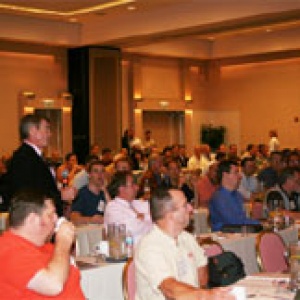Heritage Makes a Strong Showing at Annual Leica Geosystems User Conference
October 31, 2007
The documentation of sites of cultural heritage made a strong showing, among the usual industrial applications for laser scanning, at the Leica Geosystems User Conference held in San Ramon, California October 22-24. Speakers delivering presentations of their work at important cultural heritage site world wide demonstrated that the cultural heritage is one of laser scanning’s growing markets
Heritage topics shared the stage with issues such as: Post-Katrina surveys of New Orleans levees, forensic simulations, industrial plant management, oil rig construction, new software and hardware capabilities. Douglas Pritchard of The Glasgow School of Art led off by demonstrating new work and optimized workflows in the 3D mapping and modeling of historic Glasgow. Keynote speaker Carlo Bianchini of the University of Rome, La Sapienza presented technological breakthroughs in documenting and modeling the Coliseum and Antonio da Sangallo’s unbuilt model of St. Peter’s. Alfonso Ippolito, also of the University of Rome, spoke about optimizing workflows in the scanning of historic domed structures. Erwin Christofori of Ingenieurburo Christofori und Partner presented case studies of important heritage projects in Germany, most notably a phased series of historic reconstructions based on point cloud data of the Sebaldus Cathedral in Nurenburg. In the conference’s closing address Simon Barnes, Managing Partner of Plowman Craven Associates in the UK, noted how historic reconstructions derived from scan data are playing an important role in the movie and entertainment industry.
Attending, but not presenting this year, were other leaders in the area of laser scan documentation of cultural heritage sites, among whom were Peter Borges of Documenta, Sean McDaniels of the Nevada DOT, Adam Spring of University of Exeter, Sorin Busuioc President of SCDS PRO, Scott Cedarleaf of PCA, and Elizabeth Louden of Texas Tech University.
CyArk presented its work at a booth that was heavily visited by conference attendees who numbered in the high 200s. CyArk also conducted a well attended session for CyArk Partners and others involved in documenting cultural heritage. The interest was a testament to the degree to which laser scanning and other advanced documentation technologies are being increasingly applied in this area. After an introduction by Cyra Technologies and CyArk founder Ben Kacyra, CyArk unveiled CyArk SITE MANAGER™, a new integrated suite of software developed by CyArk for managers of cultural heritage sites. Site Manager is a complete, web-hosted solution to organizing, managing, archiving and presenting High Definition Documentation (HDD) data. CyArk SITE MANAGER™ provides all the functions and benefits of the CyArk Internet archive - database administration, media services, robust security, rights management, mapping and interactive tools as a web-based application. CyArk SITE MANAGER™ is the product of over two years of research and development that went into making the tools and features that engine that powers cyark.org. The new web application was received with enthusiasm by those present and a lively discussion ensued. CyArk SITE MANAGER™ currently exists as a beta application and will soon be shared with select CyArk Partners for use and beta testing.
Heritage topics shared the stage with issues such as: Post-Katrina surveys of New Orleans levees, forensic simulations, industrial plant management, oil rig construction, new software and hardware capabilities. Douglas Pritchard of The Glasgow School of Art led off by demonstrating new work and optimized workflows in the 3D mapping and modeling of historic Glasgow. Keynote speaker Carlo Bianchini of the University of Rome, La Sapienza presented technological breakthroughs in documenting and modeling the Coliseum and Antonio da Sangallo’s unbuilt model of St. Peter’s. Alfonso Ippolito, also of the University of Rome, spoke about optimizing workflows in the scanning of historic domed structures. Erwin Christofori of Ingenieurburo Christofori und Partner presented case studies of important heritage projects in Germany, most notably a phased series of historic reconstructions based on point cloud data of the Sebaldus Cathedral in Nurenburg. In the conference’s closing address Simon Barnes, Managing Partner of Plowman Craven Associates in the UK, noted how historic reconstructions derived from scan data are playing an important role in the movie and entertainment industry.
Attending, but not presenting this year, were other leaders in the area of laser scan documentation of cultural heritage sites, among whom were Peter Borges of Documenta, Sean McDaniels of the Nevada DOT, Adam Spring of University of Exeter, Sorin Busuioc President of SCDS PRO, Scott Cedarleaf of PCA, and Elizabeth Louden of Texas Tech University.
CyArk presented its work at a booth that was heavily visited by conference attendees who numbered in the high 200s. CyArk also conducted a well attended session for CyArk Partners and others involved in documenting cultural heritage. The interest was a testament to the degree to which laser scanning and other advanced documentation technologies are being increasingly applied in this area. After an introduction by Cyra Technologies and CyArk founder Ben Kacyra, CyArk unveiled CyArk SITE MANAGER™, a new integrated suite of software developed by CyArk for managers of cultural heritage sites. Site Manager is a complete, web-hosted solution to organizing, managing, archiving and presenting High Definition Documentation (HDD) data. CyArk SITE MANAGER™ provides all the functions and benefits of the CyArk Internet archive - database administration, media services, robust security, rights management, mapping and interactive tools as a web-based application. CyArk SITE MANAGER™ is the product of over two years of research and development that went into making the tools and features that engine that powers cyark.org. The new web application was received with enthusiasm by those present and a lively discussion ensued. CyArk SITE MANAGER™ currently exists as a beta application and will soon be shared with select CyArk Partners for use and beta testing.

Large turnout for the Annual Leica Geosystems User Conference